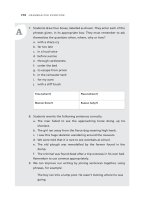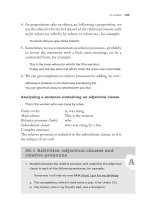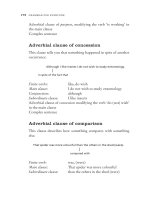Tài liệu Grammar for everyone part 2 docx
Bạn đang xem bản rút gọn của tài liệu. Xem và tải ngay bản đầy đủ của tài liệu tại đây (66.43 KB, 7 trang )
Commands 77
Exclamations 77
11 The apostrophe 80
Contractions 80
Possession 81
Avoiding confusion 82
12 Commas 84
The comma separates 85
A comma before the word ‘and’ 86
13 Inverted commas 89
14 Subject and predicate 92
Abbreviations 95
15 Objects – direct and indirect 97
The direct object 97
The indirect object 100
I or me? 101
The complement 103
16 More about verbs 108
Subjects matching verbs 109
Transitive and intransitive verbs 111
Active and passive voice 113
17 Participles 116
Present participles 116
Past participles 117
Adjectival participles and gerunds 118
18 Perfect tenses 122
The present perfect tense 122
The past perfect tense 122
The future perfect tense 123
19 More about adjectives and adverbs 128
Numeral adjectives 128
Indefinite adjectives 128
vii
c o n t e n t s
Quantitative adjectives 128
Interrogative adjectives 129
Possessive adjectives 129
Adverbs of comparison 130
Adverbs modifying other parts of speech 130
Adverbs formed from adjectives 131
20 More punctuation 132
Colons 132
Semicolons 134
Hyphens 135
Parentheses – brackets and dashes 136
Ellipsis 137
21 More pronouns 139
Interrogative pronouns 139
Possessive pronouns 140
Indefinite and distributive pronouns 140
22 Emphasis 143
23 Mood 145
Indicative mood 146
Imperative mood 146
Subjunctive or conditional mood 146
24 Case 150
Nominative 150
Accusative 150
Dative 150
Genitive 151
Vocative 151
25 Phrases 153
Adjectival phrases 154
Adverbial phrases 155
Noun phrases 155
viii
c o n t e n t s
26 Clauses 160
Main clauses 162
Subordinate clauses 163
Adjectival clauses and relative pronouns 164
Adverbial clauses 167
Adverbial clause of time 168
Adverbial clause of place 168
Adverbial clause of reason 169
Adverbial clause of manner 169
Adverbial clause of condition 170
Adverbial clause of result 170
Adverbial clause of purpose 171
Adverbial clause of concession 172
Adverbial clause of comparison 172
Noun clause 174
27 Clause analysis 177
Format 1 – clause analysis chart 178
Format 2 – clause analysis table 179
Format 3 – clause analysis tree 182
28 Word building 188
29 Improve the way you speak and write 192
Confusion between words 192
Past tense and past participle 195
Double negatives 195
Double comparatives 196
Redundant adverbs 196
30 A final word 198
Bibliography 200
Glossary 202
Index 208
ix
c o n t e n t s
Dedication
To my daughter and business partner Sarah,
who is my constant supporter and critic.
And to Gavin, also our business partner,
supporter and friend.
Acknowledgment
Thank you to my husband John who suffers my long
work hours and sometime distraction!
and Karen Pennell, my patient and efficient typist who
reads my handwriting remarkably well.
Also I acknowledge all of our Quantum Literacy Tutors,
supporters and friends, who have been enthusiastically
awaiting the book.
I
Teaching
grammar
Part I
This page intentionally left blank
Grammar – background
and history
Grammar instruction
The word ‘grammar’ often invokes a negative reaction in both
teachers and students. Many teachers have come through a period in
which grammar was neglected; for others, grammar has been taught
in a haphazard way. What has brought about this situation?
During the 1960s and 70s, many believed that traditional
elements of scholarship should be updated to suit the practices of
contemporary education. There followed a period of uncertainty.
No one was sure whether grammar instruction should take place
or not. Often, if they believed it should, the new curriculum failed
to allow it.
However, many in the profession believed that the absence of
grammar instruction was contributing to a lowering of literacy
levels. As a return to the grammar instruction courses of the past
would be unacceptable, a supposed solution was devised – a system
which became known as new or functional grammar. This system
involved the generalisation of grammatical terms, and stressed the
function that language performs, rather than the parts of speech
described in traditional grammar.
But before the age of 12 or 13 – long after the need for basic
grammar tuition – children do not normally begin to think
in abstract terms. No wonder that both parents and teachers
complained that the children disliked ‘new’ grammar, while they
themselves found it difficult to follow.
…
3









